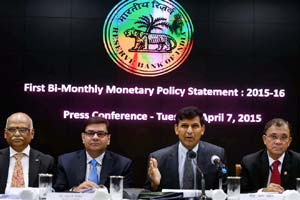Given how banks responded to the Reserve Bank of India’s refusal to cut policy rates without meaningful transmission of the previous cuts of 50 basis points, the central bank is likely to continue to trim the repo rate.
While some economists believe the central bank has room to trim the policy rate, currently at 7.5%, by just about 25 basis points over the course of a year, given that it is looking at a real interest rate of between 1.5% and 2% and an inflation rate of 5.8% by March, 2016, RBI governor Raghuram Rajan on Tuesday suggested there could be more. “There is room if we want to look for it. We need all the other pieces to fall in place,” he said. Rajan added that the timing of further cuts would depend on incoming data but the stance which turned accommodative in January would stay.
While acknowledging that the higher interest rates on small savings were an issue, Rajan observed that banks’ marginal cost of funds had fallen to 7.5% and that there was ample liquidity to warrant transmission. “There has to be both a willingness for banks to move as also flexibility while calculating the rate,” he asserted at a press conference, adding there seemed to be quicker transmission when policy rates were headed up.
While banks are to be asked to price their base rates on the basis of the marginal cost of funds rather than the average cost, since the former is considered to be more sensitive to policy rate changes, they are not sure how that would work. State Bank of India chairman Arundhati Bhattacharya, for instance, felt repricing of base rates on the basis of marginal costs might not happen immediately and could take a long transition period.
“We are fixed on the liability side so it can’t happen tomorrow,” Bhattacharya added.
The governor said the hike in interest rates by the US Federal Reserve would not be a key determinant of monetary policy and that it would be focused on local requirements. “The Fed’s policy changes will have an impact but it will be one factor and we doubt it will be constraining,” the governor said, adding that the improved macroeconomic conditions were a buffer.


